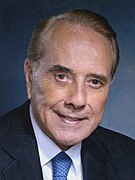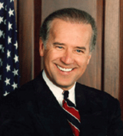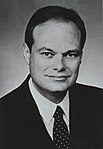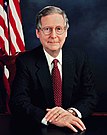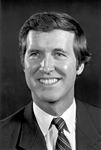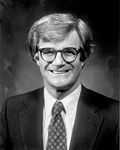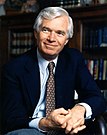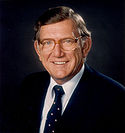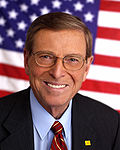1990 United States Senate elections
| ||||||||||||||||||||||||||||||||||||||||
35 of the 100 seats in the United States Senate 51 seats needed for a majority | ||||||||||||||||||||||||||||||||||||||||
|---|---|---|---|---|---|---|---|---|---|---|---|---|---|---|---|---|---|---|---|---|---|---|---|---|---|---|---|---|---|---|---|---|---|---|---|---|---|---|---|---|
| ||||||||||||||||||||||||||||||||||||||||
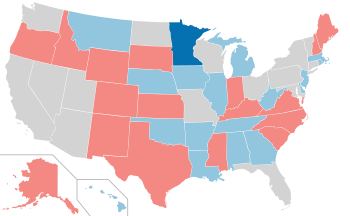 Results of the elections: Democratic gain Democratic hold Republican hold No election | ||||||||||||||||||||||||||||||||||||||||
| ||||||||||||||||||||||||||||||||||||||||
The 1990 United States Senate elections were held on Tuesday, November 6, 1990, with the 33 seats of Class 2 contested in regular elections. Special elections were also held to fill vacancies. The Democratic Party increased its majority with a net gain of one seat from the Republican Party. The election cycle took place in the middle of President George H. W. Bush's term, and as with most other midterm elections, the party not holding the presidency gained seats in Congress. This was the first time since 1980 that any party successfully defended all their own seats, and the first time Democrats did so since 1958.
These elections, along with 2022, featured the smallest seat change in history since the passage of the Seventeenth Amendment in 1913 with only one seat changing parties. That election featured Democrat Paul Wellstone defeating incumbent Republican Rudy Boschwitz in Minnesota. To date, this is the last cycle in which Democratic candidates won U.S. Senate elections in Oklahoma and Tennessee.
Results summary
[edit]| 56 | 44 |
| Democratic | Republican |
| Parties | Total | ||||||||||||||||||||||||||||||||||||||||||||||||||||||||||||||||||||||||||||||||||||||||||||||||||
|---|---|---|---|---|---|---|---|---|---|---|---|---|---|---|---|---|---|---|---|---|---|---|---|---|---|---|---|---|---|---|---|---|---|---|---|---|---|---|---|---|---|---|---|---|---|---|---|---|---|---|---|---|---|---|---|---|---|---|---|---|---|---|---|---|---|---|---|---|---|---|---|---|---|---|---|---|---|---|---|---|---|---|---|---|---|---|---|---|---|---|---|---|---|---|---|---|---|---|---|
| Democratic | Republican | Libertarian | Independent | Other | |||||||||||||||||||||||||||||||||||||||||||||||||||||||||||||||||||||||||||||||||||||||||||||||
| Last elections (1988) Before these elections |
55 | 45 | 0 | 0 | 0 | 100 | |||||||||||||||||||||||||||||||||||||||||||||||||||||||||||||||||||||||||||||||||||||||||||||
| Not up | 38 | 27 | — | — | — | 65 | |||||||||||||||||||||||||||||||||||||||||||||||||||||||||||||||||||||||||||||||||||||||||||||
| Up | 17 | 18 | — | — | — | 35 | |||||||||||||||||||||||||||||||||||||||||||||||||||||||||||||||||||||||||||||||||||||||||||||
| Class 2 (1984→1990) | 16 | 17 | — | — | — | 33 | |||||||||||||||||||||||||||||||||||||||||||||||||||||||||||||||||||||||||||||||||||||||||||||
| Special: Class 1 | 1 | — | — | — | — | 1 | |||||||||||||||||||||||||||||||||||||||||||||||||||||||||||||||||||||||||||||||||||||||||||||
| Special: Class 3 | — | 1 | — | — | — | 1 | |||||||||||||||||||||||||||||||||||||||||||||||||||||||||||||||||||||||||||||||||||||||||||||
| Incumbent retired | 0 | 3 | — | — | — | 3 | |||||||||||||||||||||||||||||||||||||||||||||||||||||||||||||||||||||||||||||||||||||||||||||
| Held by same party | 0 | 3 | — | — | — | 3 | |||||||||||||||||||||||||||||||||||||||||||||||||||||||||||||||||||||||||||||||||||||||||||||
| Replaced by other party | 0 | 0 | — | — | — | 0 | |||||||||||||||||||||||||||||||||||||||||||||||||||||||||||||||||||||||||||||||||||||||||||||
| Result | 0 | 3 | — | — | — | 3 | |||||||||||||||||||||||||||||||||||||||||||||||||||||||||||||||||||||||||||||||||||||||||||||
| Incumbent ran | 17 | 15 | — | — | — | 32 | |||||||||||||||||||||||||||||||||||||||||||||||||||||||||||||||||||||||||||||||||||||||||||||
| Won election | 17 | 14 | — | — | — | 31 | |||||||||||||||||||||||||||||||||||||||||||||||||||||||||||||||||||||||||||||||||||||||||||||
| Lost re-election | — | — | — | 1 | |||||||||||||||||||||||||||||||||||||||||||||||||||||||||||||||||||||||||||||||||||||||||||||||
| Lost renomination, but held by same party |
0 | 0 | — | — | — | 0 | |||||||||||||||||||||||||||||||||||||||||||||||||||||||||||||||||||||||||||||||||||||||||||||
| Result | 18 | 14 | — | — | — | 32 | |||||||||||||||||||||||||||||||||||||||||||||||||||||||||||||||||||||||||||||||||||||||||||||
| Total elected | 18 | 17 | — | — | — | 35 | |||||||||||||||||||||||||||||||||||||||||||||||||||||||||||||||||||||||||||||||||||||||||||||
| Net gain/loss | 1 | ||||||||||||||||||||||||||||||||||||||||||||||||||||||||||||||||||||||||||||||||||||||||||||||||||
| Nationwide vote[a] | 17,907,544 | 16,494,624 | 142,003 | 222,534 | 260,665 | 35,027,370 | |||||||||||||||||||||||||||||||||||||||||||||||||||||||||||||||||||||||||||||||||||||||||||||
| Share | 51.12% | 47.09% | 0.41% | 0.64% | 0.74% | 100% | |||||||||||||||||||||||||||||||||||||||||||||||||||||||||||||||||||||||||||||||||||||||||||||
| Result | 56 | 44 | 0 | 0 | 0 | 100 | |||||||||||||||||||||||||||||||||||||||||||||||||||||||||||||||||||||||||||||||||||||||||||||
Source: Clerk of the United States House of Representatives[1]
Gains, losses, and holds
[edit]Retirements
[edit]Three Republicans retired instead of seeking re-election.
| State | Senator | Replaced by |
|---|---|---|
| Colorado | William L. Armstrong | Hank Brown |
| Idaho | James A. McClure | Larry Craig |
| New Hampshire | Gordon J. Humphrey | Bob Smith |
Defeats
[edit]One Republican sought re-election but lost in the general election.
| State | Senator | Replaced by |
|---|---|---|
| Minnesota | Rudy Boschwitz | Paul Wellstone |
Post-election changes
[edit]| State | Senator | Replaced by |
|---|---|---|
| California (Class 1) |
Pete Wilson | John Seymour |
| Pennsylvania (Class 1) |
John Heinz | Harris Wofford |
| North Dakota (Class 1) |
Quentin Burdick | Jocelyn Burdick |
Change in composition
[edit]Before the elections
[edit]| D1 | D2 | D3 | D4 | D5 | D6 | D7 | D8 | D9 | D10 |
| D20 | D19 | D18 | D17 | D16 | D15 | D14 | D13 | D12 | D11 |
| D21 | D22 | D23 | D24 | D25 | D26 | D27 | D28 | D29 | D30 |
| D40 Ark. Ran |
D39 Ala. Ran |
D38 | D37 | D36 | D35 | D34 | D33 | D32 | D31 |
| D41 Del. Ran |
D42 Ga. Ran |
D43 Hawaii (sp) Ran |
D44 Ill. Ran |
D45 Iowa Ran |
D46 La. Ran |
D47 Mass. Ran |
D48 Mich. Ran |
D49 Mont. Ran |
D50 Neb. Ran |
| Majority → | D51 N.J. Ran | ||||||||
| R41 S.C. Ran |
R42 S.D. Ran |
R43 Texas Ran |
R44 Va. Ran |
R45 Wyo. Ran |
D55 W.Va. Ran |
D54 Tenn. Ran |
D53 R.I. Ran |
D52 Okla. Ran | |
| R40 Ore. Ran |
R39 N.C. Ran |
R38 N.M. Ran |
R37 N.H. Retired |
R36 Miss. Ran |
R35 Minn. Ran |
R34 Me. Ran |
R33 Ky. Ran |
R32 Kan. Ran |
R31 Ind. (sp) Ran |
| R21 | R22 | R23 | R24 | R25 | R26 | R27 | R28 Alaska Ran |
R29 Colo. Retired |
R30 Idaho Retired |
| R20 | R19 | R18 | R17 | R16 | R15 | R14 | R13 | R12 | R11 |
| R1 | R2 | R3 | R4 | R5 | R6 | R7 | R8 | R9 | R10 |
Result of the elections
[edit]| D1 | D2 | D3 | D4 | D5 | D6 | D7 | D8 | D9 | D10 |
| D20 | D19 | D18 | D17 | D16 | D15 | D14 | D13 | D12 | D11 |
| D21 | D22 | D23 | D24 | D25 | D26 | D27 | D28 | D29 | D30 |
| D40 Ark. Re-elected |
D39 Ala. Re-elected |
D38 | D37 | D36 | D35 | D34 | D33 | D32 | D31 |
| D41 Del. Re-elected |
D42 Ga. Re-elected |
D43 Hawaii (sp) Elected[b] |
D44 Ill. Re-elected |
D45 Iowa Re-elected |
D46 La. Re-elected |
D47 Mass. Re-elected |
D48 Mich. Re-elected |
D49 Mont. Re-elected |
D50 Neb. Re-elected |
| Majority → | D51 N.J. Re-elected | ||||||||
| R41 S.D. Re-elected |
R42 Texas Re-elected |
R43 Va. Re-elected |
R44 Wyo. Re-elected |
D56 Minn. Gain |
D55 W.Va. Re-elected |
D54 Tenn. Re-elected |
D53 R.I. Re-elected |
D52 Okla. Re-elected | |
| R40 S.C. Re-elected |
R39 Ore. Re-elected |
R38 N.C. Re-elected |
R37 N.M. Re-elected |
R36 N.H. Hold |
R35 Miss. Re-elected |
R34 Me. Re-elected |
R33 Ky. Re-elected |
R32 Kan. Re-elected |
R31 Ind. (sp) Elected[b] |
| R21 | R22 | R23 | R24 | R25 | R26 | R27 | R28 Alaska Re-elected |
R29 Colo. Hold |
R30 Idaho Hold |
| R20 | R19 | R18 | R17 | R16 | R15 | R14 | R13 | R12 | R11 |
| R1 | R2 | R3 | R4 | R5 | R6 | R7 | R8 | R9 | R10 |
| Key |
|
|---|
Complete list of races
[edit]Special elections
[edit]In these special elections, the winners were elected in 1990.
Elections are sorted by date, then state and class.
| State | Incumbent | Result | Candidates | ||
|---|---|---|---|---|---|
| Senator | Party | Electoral history | |||
| Hawaii (Class 1) |
Daniel Akaka | Democratic | 1990 (appointed) | Interim appointee elected November 6, 1990. |
|
| Indiana (Class 3) |
Dan Coats | Republican | 1989 (appointed) | Interim appointee elected November 6, 1990. |
|
Elections leading to the next Congress
[edit]In these general elections, the winners were elected for the term beginning January 3, 1991; ordered by state.
All of the elections involved the Class 2 seats.
| State | Incumbent | Result | Candidates | ||
|---|---|---|---|---|---|
| Senator | Party | Electoral history | |||
| Alabama | Howell Heflin | Democratic | 1978 1984 |
Incumbent re-elected. |
|
| Alaska | Ted Stevens | Republican | 1968 (appointed) 1970 1972 1978 1984 |
Incumbent re-elected. |
|
| Arkansas | David Pryor | Democratic | 1978 1984 |
Incumbent re-elected. |
|
| Colorado | William L. Armstrong | Republican | 1978 1984 |
Incumbent retired. Republican hold. |
Others
|
| Delaware | Joe Biden | Democratic | 1972 1978 1984 |
Incumbent re-elected. |
|
| Georgia | Sam Nunn | Democratic | 1972 (special) 1972 1978 1984 |
Incumbent re-elected. |
|
| Idaho | James A. McClure | Republican | 1972 1978 1984 |
Incumbent retired. Republican hold. |
|
| Illinois | Paul Simon | Democratic | 1984 | Incumbent re-elected. |
|
| Iowa | Tom Harkin | Democratic | 1984 | Incumbent re-elected. |
|
| Kansas | Nancy Kassebaum | Republican | 1978 1978 (appointed) 1984 |
Incumbent re-elected. |
|
| Kentucky | Mitch McConnell | Republican | 1984 | Incumbent re-elected. |
|
| Louisiana | J. Bennett Johnston | Democratic | 1972 (appointed) 1972 1978 1984 |
Incumbent re-elected. |
|
| Maine | William Cohen | Republican | 1972 1978 1984 |
Incumbent re-elected. |
|
| Massachusetts | John Kerry | Democratic | 1984 | Incumbent re-elected. |
|
| Michigan | Carl Levin | Democratic | 1978 1984 |
Incumbent re-elected. |
|
| Minnesota | Rudy Boschwitz | Republican | 1978 1978 (appointed) 1984 |
Incumbent lost re-election. DFL gain. |
|
| Mississippi | Thad Cochran | Republican | 1978 1978 (appointed) 1984 |
Incumbent re-elected. |
|
| Montana | Max Baucus | Democratic | 1978 1978 (appointed) 1984 |
Incumbent re-elected. |
|
| Nebraska | J. James Exon | Democratic | 1978 1984 |
Incumbent re-elected. |
|
| New Hampshire | Gordon J. Humphrey | Republican | 1978 1984 |
Incumbent retired. Republican hold. Incumbent resigned December 4, 1990 to take a seat in the New Hampshire Senate. Winner appointed December 7, 1990. |
|
| New Jersey | Bill Bradley | Democratic | 1978 1984 |
Incumbent re-elected. |
Others
|
| New Mexico | Pete Domenici | Republican | 1972 1978 1984 |
Incumbent re-elected. |
|
| North Carolina | Jesse Helms | Republican | 1972 1978 1984 |
Incumbent re-elected. |
|
| Oklahoma | David Boren | Democratic | 1978 1984 |
Incumbent re-elected. |
|
| Oregon | Mark Hatfield | Republican | 1966 1972 1978 1984 |
Incumbent re-elected. |
|
| Rhode Island | Claiborne Pell | Democratic | 1960 1966 1972 1978 1984 |
Incumbent re-elected. |
|
| South Carolina | Strom Thurmond | Republican | 1954 (write-in)[c] 1954 (appointed) 1956 (resigned) 1956 (special) 1960 1966 1972 1978 1984 |
Incumbent re-elected. |
Others
|
| South Dakota | Larry Pressler | Republican | 1978 1984 |
Incumbent re-elected. |
|
| Tennessee | Al Gore | Democratic | 1984 | Incumbent re-elected. |
Others
|
| Texas | Phil Gramm | Republican | 1984 | Incumbent re-elected. |
|
| Virginia | John Warner | Republican | 1978 1979 (appointed) 1984 |
Incumbent re-elected. |
|
| West Virginia | Jay Rockefeller | Democratic | 1984 | Incumbent re-elected. |
|
| Wyoming | Alan Simpson | Republican | 1978 1979 (appointed) 1984 |
Incumbent re-elected. |
|
Closest races
[edit]In eight races the margin of victory was under 10%.
| State | Party of winner | Margin |
|---|---|---|
| Minnesota | Democratic (flip) | 2.63% |
| New Jersey | Democratic | 3.04% |
| Kentucky | Republican | 4.38% |
| North Carolina | Republican | 5.19% |
| South Dakota | Republican | 7.32% |
| Oregon | Republican | 7.49% |
| Iowa | Democratic | 9.05% |
| Hawaii (special) | Democratic | 9.37% |
Michigan was the tipping point state with a margin of 16.3%.
Alabama
[edit]
| |||||||||||||||||
| |||||||||||||||||
 County results Heflin: 50–60% 60–70% 70–80% 80–90% Cabaniss: 50–60% | |||||||||||||||||
| |||||||||||||||||
Incumbent Democrat Howell Heflin won re-election to a third term over Republican Bill Cabaniss, State Senator and former State Representative. This was the last time the Democrats have won the Class 2 Senate Seat from Alabama until Doug Jones won the seat in 2017.
| Party | Candidate | Votes | % | ±% | |
|---|---|---|---|---|---|
| Democratic | Howell Heflin (Incumbent) | 717,814 | 60.67% | −2.00% | |
| Republican | William J. Cabaniss | 467,190 | 39.43% | +3.00% | |
| Total votes | 1,184,954 | 100.00% | |||
| Majority | 250,624 | 21.24% | |||
| Democratic hold | Swing | ||||
Alaska
[edit]
| |||||||||||||||||
 Results by state house district Stevens: 50–60% 60–70% 70–80% | |||||||||||||||||
| |||||||||||||||||
Incumbent Republican United States Senator Ted Stevens sought re-election to a fifth term in the United States Senate, which he won easily, besting his opponents in a landslide.
| Party | Candidate | Votes | % | |
|---|---|---|---|---|
| Republican | Ted Stevens (Incumbent) | 81,968 | 59.19% | |
| Republican | John Havelock | 34,824 | 25.15% | |
| Democratic | Michael Beasley | 12,371 | 8.93% | |
| Democratic | Tom Taggart | 9,329 | 6.74% | |
| Total votes | 138,492 | 100.00% | ||
| Party | Candidate | Votes | % | ±% | |
|---|---|---|---|---|---|
| Republican | Ted Stevens (Incumbent) | 125,806 | 66.23% | −4.94% | |
| Democratic | Michael Beasley | 61,152 | 32.19% | +3.71% | |
| Write-ins | 2,999 | 1.58% | |||
| Majority | 64,654 | 34.04% | −8.65% | ||
| Turnout | 189,957 | ||||
| Republican hold | Swing | ||||
Arkansas
[edit]
| |||||||||||||||||
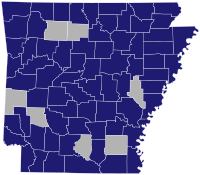 County results Pryor: 100% No data/No votes: | |||||||||||||||||
| |||||||||||||||||
Incumbent Democrat David Pryor won re-election uncontested.[4]
| Party | Candidate | Votes | % | |
|---|---|---|---|---|
| Democratic | David Pryor (Incumbent) | 493,910 | 99.83% | |
| Independent | Betty White (write-in) | 825 | 0.17% | |
| Majority | 493,085 | 99.67% | ||
| Turnout | 494,735 | |||
| Democratic hold | ||||
Colorado
[edit]
| |||||||||||||||||
| |||||||||||||||||
 County results Brown: 50–60% 60–70% 70–80% 80–90% Heath: 40–50% 50–60% 60–70% | |||||||||||||||||
| |||||||||||||||||
Incumbent Republican senator William L. Armstrong did not seek re-election to another term. Republican congressman Hank Brown won the open seat, defeating Democratic nominee Josie Heath, former Boulder County Commissioner[5]
| Party | Candidate | Votes | % | |
|---|---|---|---|---|
| Republican | Hank Brown | 569,048 | 55.68% | |
| Democratic | Josie Heath | 425,746 | 41.66% | |
| Concerns of People | John Heckman | 15,432 | 1.51% | |
| Colorado Prohibition | Earl F. Dodge | 11,801 | 1.15% | |
| Write-In | Others | 32 | 0.00% | |
| Majority | 143,302 | 14.02% | ||
| Turnout | 1,022,059 | |||
| Republican hold | ||||
Delaware
[edit]
| |||||||||||||||||
 County results Biden: 50–60% 60–70% | |||||||||||||||||
| |||||||||||||||||
Incumbent Democrat Joe Biden won re-election to a fourth term, defeating Republican challenger M. Jane Brady, Deputy Attorney General of Delaware.
| Party | Candidate | Votes | % | ±% | |
|---|---|---|---|---|---|
| Democratic | Joe Biden (Incumbent) | 112,918 | 62.68% | +2.57% | |
| Republican | M. Jane Brady | 64,554 | 35.83% | −4.06% | |
| Libertarian | Lee Rosenbaum | 2,680 | 1.49% | ||
| Write-ins | 5 | 0.00% | |||
| Majority | 48,364 | 26.85% | +6.62% | ||
| Turnout | 180,157 | ||||
| Democratic hold | Swing | ||||
Georgia
[edit]
| |||||||||||||||||
 County results Nunn: 100% | |||||||||||||||||
| |||||||||||||||||
Incumbent Democrat Sam Nunn won re-election to a fourth term uncontested.[4]
| Party | Candidate | Votes | % | ±% | |
|---|---|---|---|---|---|
| Democratic | Sam Nunn (Incumbent) | 1,033,439 | 100.00% | +20.06% | |
| Majority | 1,033,439 | 100.00% | +40.12% | ||
| Turnout | 1,033,439 | ||||
| Democratic hold | Swing | ||||
Hawaii (special)
[edit]
| |||||||||||||||||
 County results Akaka: 50–60% 60–70% | |||||||||||||||||
| |||||||||||||||||
Incumbent Democrat Daniel Akaka was elected to finish the term ending in 1995 over Republican U.S. Representative Pat Saiki. Akaka had been appointed by Governor John Waihee in April 1990 to serve temporarily after the death of Spark Matsunaga.[7]
| Party | Candidate | Votes | % | |
|---|---|---|---|---|
| Democratic | Daniel Akaka (incumbent) | 188,901 | 53.72% | |
| Republican | Pat Saiki | 155,978 | 44.35% | |
| Libertarian | Ken Schoolland | 6,788 | 1.93% | |
| Majority | 32,923 | 9.36% | ||
| Turnout | 351,666 | |||
| Democratic hold | ||||
Idaho
[edit]
| |||||||||||||||||
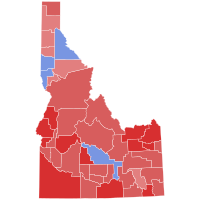 County results Craig: 50–60% 60–70% 70–80% Twilegar: 50–60% | |||||||||||||||||
| |||||||||||||||||
Republican Rep. Larry Craig defeated Democratic former state legislator Ron Twilegar for the seat of U.S. Senator Jim McClure, who did not seek re-election.
| Party | Candidate | Votes | % | |
|---|---|---|---|---|
| Republican | Larry Craig | 65,830 | 59.01% | |
| Republican | Jim Jones | 45,733 | 40.99% | |
| Party | Candidate | Votes | % | |
|---|---|---|---|---|
| Democratic | Ron Twilegar | 30,154 | 64.51% | |
| Democratic | David C. Steed | 16,587 | 35.49% | |
| Party | Candidate | Votes | % | |
|---|---|---|---|---|
| Republican | Larry Craig | 193,641 | 61.29% | |
| Democratic | Ron Twilegar | 122,295 | 38.71% | |
| Total votes | 315,936 | 100.00% | ||
| Majority | 71,346 | 22.58% | ||
| Republican hold | ||||
Illinois
[edit]
| |||||||||||||||||
 County results Simon: 50–60% 60–70% 70–80% 80–90% Martin: 50–60% | |||||||||||||||||
| |||||||||||||||||
Incumbent Democrat Paul Simon sought re-election to the United States Senate. Simon was opposed by Republican nominee Lynn Morley Martin, a United States Congresswoman from Illinois's 16th congressional district, whom he easily defeated to win a second and final term in the Senate.
| Party | Candidate | Votes | % | ±% | |
|---|---|---|---|---|---|
| Democratic | Paul Simon (Incumbent) | 2,115,377 | 65.07% | +15.00% | |
| Republican | Lynn Morley Martin | 1,135,628 | 34.93% | −13.28% | |
| Majority | 979,749 | 30.14% | +28.28% | ||
| Turnout | 3,251,005 | ||||
| Democratic hold | Swing | ||||
Indiana (special)
[edit]
| |||||||||||||||||
 County results Coats: 50–60% 60–70% 70–80% Hill: 50–60% 60–70% | |||||||||||||||||
| |||||||||||||||||
Incumbent Republican Dan Coats, who was recently appointed to this seat two years prior, won election to serve out the remainder of the term, beating Democratic State Representative Baron Hill.
During the 1988 presidential election, Republican nominee Vice President George H. W. Bush selected U.S. Senator Dan Quayle of Indiana as his vice presidential nominee. The Bush-Quayle ticket defeated the Dukakis-Bentsen ticket in the general election by a 53%-46% margin, capturing 40 states and 426 electoral votes.
In preparation for the pending vacancy, Governor Robert D. Orr appointed four-term U.S. Representative Dan Coats to fill Quayle's seat on December 12, 1988. Coats was a former aide to Quayle, whom he had succeeded as U.S. Representative for Indiana's 4th congressional district in 1981. Quayle eventually resigned his Senate seat on January 3, 1989, and Coats was immediately sworn into office.
Coats used television commercials that raised questions about Hill's consistency in opposing new taxes, and Hill gained notoriety for walking the length of the state to meet voters.
| Party | Candidate | Votes | % | ±% | |
|---|---|---|---|---|---|
| Republican | Dan Coats (Incumbent) | 806,048 | 53.6% | −6.93% | |
| Democratic | Baron Hill | 696,639 | 46.4% | +7.85% | |
| Majority | 109,409 | 7.28% | |||
| Turnout | 1,502,687 | ||||
| Republican hold | Swing | ||||
Iowa
[edit]
| |||||||||||||||||
| |||||||||||||||||
 County results Harkin: 50–60% 60–70% Tauke: 50–60% 60–70% 70–80% | |||||||||||||||||
| |||||||||||||||||
Incumbent Democrat Tom Harkin sought re-election to a second term in the United States Senate. Harkin was opposed by Republican United States Congressman Tom Tauke, from Iowa's 2nd congressional district, and both Harkin and Tauke won their primaries uncontested. Though Harkin performed slightly worse than he had six years earlier, he was successful in his re-election bid and defeated Tauke.
| Party | Candidate | Votes | % | |
|---|---|---|---|---|
| Democratic | Tom Harkin (Incumbent) | 162,661 | 99.47% | |
| Democratic | Write-ins | 867 | 0.53% | |
| Total votes | 163,528 | 100.00% | ||
| Party | Candidate | Votes | % | |
|---|---|---|---|---|
| Republican | Tom Tauke | 91,798 | 99.81% | |
| Republican | Write-ins | 172 | 0.19% | |
| Total votes | 91,970 | 100.00% | ||
| Party | Candidate | Votes | % | ±% | |
|---|---|---|---|---|---|
| Democratic | Tom Harkin (Incumbent) | 535,975 | 54.47% | −0.98% | |
| Republican | Tom Tauke | 446,869 | 45.42% | +1.76% | |
| Write-ins | 1,089 | 0.11% | |||
| Majority | 89,106 | 9.06% | −2.74% | ||
| Turnout | 983,933 | ||||
| Democratic hold | Swing | ||||
Kansas
[edit]
| |||||||||||||||||
| |||||||||||||||||
 County results Kassebaum: 60–70% 70–80% 80–90% | |||||||||||||||||
| |||||||||||||||||
Incumbent Republican Nancy Kassebaum won re-election to her third full term, over Democrat Dick Williams, an educator at Wichita State University[12]
| Party | Candidate | Votes | % | |
|---|---|---|---|---|
| Republican | Nancy Kassebaum (Incumbent) | 578,605 | 73.6% | |
| Democratic | Dick Williams | 207,491 | 26.4% | |
| Total votes | 786,096 | 100.00% | ||
| Majority | 371,114 | 47.2% | ||
| Republican hold | ||||
Kentucky
[edit]
| |||||||||||||||||
 County results McConnell: 50–60% 60–70% 70–80% 80–90% Sloane: 50–60% 60–70% 70–80% | |||||||||||||||||
| |||||||||||||||||
Incumbent Republican Mitch McConnell won re-election to a second term over Democrat Harvey Sloane, former Mayor of Louisville
| Party | Candidate | Votes | % | |
|---|---|---|---|---|
| Democratic | Harvey I. Sloane | 183,789 | 59.27% | |
| Democratic | John Brock | 126,318 | 40.73% | |
| Total votes | 310,107 | 100.00% | ||
| Party | Candidate | Votes | % | |
|---|---|---|---|---|
| Republican | Mitch McConnell (Incumbent) | 64,063 | 88.52% | |
| Republican | Tommy Klein | 8,310 | 11.48% | |
| Total votes | 72,373 | 100.00% | ||
| Party | Candidate | Votes | % | ±% | |
|---|---|---|---|---|---|
| Republican | Mitch McConnell (Incumbent) | 478,034 | 52.19% | +2.28% | |
| Democratic | Harvey I. Sloane | 437,976 | 47.81% | −1.68% | |
| Majority | 40,058 | 4.37% | +3.97% | ||
| Turnout | 916,010 | ||||
| Republican hold | Swing | ||||
Louisiana
[edit]
| |||||||||||||||||
| |||||||||||||||||
 Parish results Johnston: 40–50% 50–60% 60–70% 70–80% Duke: 40–50% 50–60% 60–70% | |||||||||||||||||
| |||||||||||||||||
Incumbent Democrat J. Bennett Johnston Jr. won re-election to a fourth term and avoided a runoff, beating Republican David Duke, State Representative and former Grand Wizard of the Ku Klux Klan.
This election was viewed at the onset as potentially competitive, as Senator Johnston was viewed as vulnerable in light of Louisiana's economic troubles at the time and Senator Johnston's voting record viewed by Republicans as too liberal. The Republican Party leadership endorsed the candidacy of State Senator Ben Bagert, who was picked over Secretary of State Fox McKeithen, State Representative Quentin Dastugue and State Representative David Duke.[15] David Duke, however, continued his candidacy and slowly overtook Bagert in attention and in the polls. Duke attracted national attention to the race with his involvement with white supremacist groups and his appeals to white resentment over affirmative-action programs. With Bagert failing to gain traction, the National Republican Senatorial Committee tried to recruit former Governor David Treen to jump into the race. When Treen passed, the effort turned from supporting Bagert to stopping Duke.[16]
As the election drew near, polls showed Johnston firmly in first place, with Duke in second place and Bagert trailing far behind at third. National Republicans grew fearful that Bagert's candidacy would only serve to force a runoff and that a potential runoff election with Duke being the de facto Republican nominee would hurt the national brand. On October 4, eight Republican Senators endorsed Johnston, with Senator John Danforth saying at the press conference that "all of us would be embarrassed and mortified to have to serve in the United States Senate with David Duke masquerading as a Republican." Bagert dropped out of the race the next day, announcing that "it became more and more apparent, that instead of forcing a runoff between myself and Bennett Johnston, I might very well be forcing a runoff between somebody else and Bennett Johnston." He announced he would "reluctantly" vote for Johnston.[17] Bagert's name remained on the ballot, but under state law his votes could not be counted as part of the official tally.[18] After Bagert dropped out, HUD Secretary Jack Kemp endorsed Johnston, saying "there's no place in the Republican Party for someone who has practiced and practices racism, bigotry and anti-Semitism."[19]
| Party | Candidate | Votes | % | |
|---|---|---|---|---|
| Democratic | J. Bennett Johnston Jr. (Incumbent) | 753,198 | 53.95% | |
| Republican | David Duke | 607,091 | 43.48% | |
| Democratic | Nick Joseph Accardo | 21,578 | 1.55% | |
| Democratic | Larry Crowe | 14,345 | 1.03% | |
| Majority | 146,107 | 10.47% | ||
| Total votes | 1,396,212 | 100.00% | ||
| Democratic hold | ||||
Maine
[edit]
| |||||||||||||||||
| |||||||||||||||||
 County results Cohen: 50–60% 60–70% | |||||||||||||||||
| |||||||||||||||||
Incumbent Republican William Cohen won re-election to a third term over Democratic State Representative Neil Rolde.
| Party | Candidate | Votes | % | |
|---|---|---|---|---|
| Republican | William Cohen (Incumbent) | 319,167 | 61.3% | |
| Democratic | Neil Rolde | 201,053 | 38.6% | |
| Total votes | 520,220 | 100.00% | ||
| Majority | 118,114 | 22.7% | ||
| Republican hold | ||||
Massachusetts
[edit]
| |||||||||||||||||
| |||||||||||||||||
| |||||||||||||||||
Incumbent Democratic U.S. Senator John Kerry was re-elected to his second term over Republican real estate developer Jim Rappaport.
| Party | Candidate | Votes | % | |
|---|---|---|---|---|
| Republican | Jim Rappaport | 265,093 | 66.12% | |
| Republican | Daniel W. Daly | 135,647 | 33.38% | |
| All others | 202 | 0.05% | ||
| Party | Candidate | Votes | % | |
|---|---|---|---|---|
| Democratic | John Kerry (Incumbent) | 1,321,712 | 54.51% | |
| Republican | Jim Rappaport | 992,917 | 40.95% | |
| Independent | David Pover | 109,950 | 4.54% | |
| Turnout | 2,424,579 | 100.00% | ||
| Majority | 328,795 | 13.56% | ||
| Democratic hold | ||||
Michigan
[edit]
| |||||||||||||||||
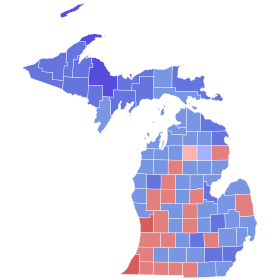 County results Levin: 40–50% 50–60% 60–70% 70–80% Schuette: 40–50% 50–60% 60–70% | |||||||||||||||||
| |||||||||||||||||
Incumbent Democrat Carl Levin won re-election to a third term, beating Republican U.S. Representative Bill Schuette.
| Party | Candidate | Votes | % | |
|---|---|---|---|---|
| Democratic | Carl Levin (Incumbent) | 1,471,753 | 57.4% | |
| Republican | Bill Schuette | 1,055,695 | 41.2% | |
| Workers World | Susan Farquhar | 32,796 | 1.3% | |
| Total votes | 2,560,244 | 100.00% | ||
| Majority | 416,058 | 16.2% | ||
| Democratic hold | ||||
Minnesota
[edit]
| |||||||||||||||||
| |||||||||||||||||
 County results Wellstone: 40–50% 50–60% 60–70% Boschwitz: 40–50% 50–60% 60–70% | |||||||||||||||||
| |||||||||||||||||
Incumbent Republican Rudy Boschwitz was defeated by Democratic challenger Paul Wellstone in a tight race. Widely considered an underdog and outspent by a 7-to-1 margin, Wellstone, a professor at Carleton College and nominee for Minnesota State Auditor in 1982 was the only candidate to defeat an incumbent senator in the 1990 election cycle and gained national attention after his upset victory.
| Party | Candidate | Votes | % | |||
|---|---|---|---|---|---|---|
| Democratic (DFL) | Paul Wellstone | 911,999 | 50.49% | |||
| Ind.-Republican | Rudy Boschwitz (Incumbent) | 864,375 | 47.86% | |||
| Grassroots | Russell B. Bentley[25] | 29,820 | 1.65% | |||
| Total votes | 1,806,194 | 100.00% | ||||
| Majority | 47,624 | 2.63% | ||||
| Democratic (DFL) gain from Republican | ||||||
Mississippi
[edit]
| |||||||||||||||||
 County results Cochran: >90% No vote: | |||||||||||||||||
| |||||||||||||||||
Incumbent Republican Thad Cochran won re-election to a third term.[4]
| Party | Candidate | Votes | % | |
|---|---|---|---|---|
| Republican | Thad Cochran (Incumbent) | 274,244 | 100.00% | |
| Majority | 274,244 | 100.00% | ||
| Turnout | 274,244 | |||
| Republican hold | ||||
Montana
[edit]
| |||||||||||||||||
 County results Baucus: 50–60% 60–70% 70–80% 80–90% Kostad: 40–50% | |||||||||||||||||
| |||||||||||||||||
Incumbent United States Senator Max Baucus, who was first elected in 1978 and was re-elected in 1984, ran for re-election. After winning the Democratic primary, he moved on to the general election, where he was opposed by Allen Kolstad, the Lieutenant Governor of Montana and the Republican nominee. Baucus ultimately ended up defeating Kolstad in a landslide, winning his third term with ease.
| Party | Candidate | Votes | % | |
|---|---|---|---|---|
| Democratic | Max Baucus (Incumbent) | 80,622 | 82.60% | |
| Democratic | John Driscoll | 12,616 | 12.93% | |
| Democratic | "Curly" Thornton | 4,367 | 4.47% | |
| Total votes | 97,605 | 100.00% | ||
| Party | Candidate | Votes | % | |
|---|---|---|---|---|
| Republican | Allen Kolstad | 38,097 | 43.59% | |
| Republican | Bruce Vorhauer | 30,837 | 35.28% | |
| Republican | Bill Farrell | 11,820 | 13.52% | |
| Republican | John Domenech | 6,648 | 7.61% | |
| Total votes | 87,402 | 100.00% | ||
| Party | Candidate | Votes | % | ±% | |
|---|---|---|---|---|---|
| Democratic | Max Baucus (Incumbent) | 217,563 | 68.13% | +11.24% | |
| Republican | Allen Kolstad | 93,836 | 29.38% | −11.31% | |
| Libertarian | Westley F. Deitchler | 7,937 | 2.49% | +0.07% | |
| Majority | 123,727 | 38.75% | +22.55% | ||
| Turnout | 319,336 | ||||
| Democratic hold | Swing | ||||
Nebraska
[edit]
| |||||||||||||||||
 County results Exon: 50–60% 60–70% 70–80% Daub: 50-60% 60-70% 70-80% 80-90% | |||||||||||||||||
| |||||||||||||||||
Incumbent Democrat J. James Exon won re-election to a third term, beating Republican U.S. Representative Hal Daub.
| Party | Candidate | Votes | % | ±% | |
|---|---|---|---|---|---|
| Democratic | J. James Exon (Incumbent) | 379,933 | 58.90% | +6.97% | |
| Republican | Hal Daub | 243,013 | 40.92% | −7.09% | |
| Write-ins | 1,036 | 0.17% | |||
| Majority | 106,766 | 17.98% | +14.06% | ||
| Turnout | 593,828 | ||||
| Democratic hold | Swing | ||||
New Hampshire
[edit]
| |||||||||||||||||
Smith: 40–50% 50–60% 60–70% 70–80% 80–90% >90% Durkin: 40–50% 50–60% >90% | |||||||||||||||||
| |||||||||||||||||
Incumbent Republican Gordon J. Humphrey decided to retire and not run for re-election to a third term. Republican Bob Smith won the open seat, beating Democratic former Senator John A. Durkin.
| Party | Candidate | Votes | % | |
|---|---|---|---|---|
| Republican | Bob Smith | 189,792 | 65.13% | |
| Democratic | John A. Durkin | 91,299 | 31.33% | |
| Libertarian | John G. Elsnau | 9,102 | 3.34% | |
| Write-In Candidates | 585 | 0.20% | ||
| Majority | 98,493 | 33.80% | ||
| Turnout | 291,393 | |||
| Republican hold | ||||
New Jersey
[edit]
| |||||||||||||||||
 County results Bradley: 40–50% 50–60% 60–70% Whitman: 40–50% 50–60% 60–70% | |||||||||||||||||
| |||||||||||||||||
Democratic Senator Bill Bradley decided to seek re-election and narrowly edged out little-known Republican Christine Todd Whitman, President of the New Jersey Board of Public Utilities.[4]
Senator Bill Bradley didn't realize he was in trouble of winning re-election and the New Jersey voters' anger over taxes and economy until the week prior to the election.
The senator had a major image problem. In the early part of the campaign Bradley was winning easily in the polls, so his staffers told him to play it safe. He sent out television advertisements of himself walking on the beach, shooting a perfect shot on the court, and sitting back in his office with his basketball shoes onto his desk. The advertisements backfired as voters were turned off and thought that he hadn't taken his job as Senator seriously, at a time when New Jersey voters were suffering.
Another major problem with Bradley was how Democratic Governor Jim Florio implemented a $2.8 billion tax increase, hurting the state's economy. In addition, Bradley refused to answer questions pertaining to Florio's tax policies.
After Bradley realized he was in trouble he released negative advertisements. They attacked Whitman's own record on taxes, accusing her of favoring tax increases when she was a Somerset County Freeholder. Bradley's image may have been further damaged by his newer advertisements.[28]
| Party | Candidate | Votes | % | |
|---|---|---|---|---|
| Democratic | Bill Bradley (Incumbent) | 977,810 | 50.4% | |
| Republican | Christine Todd Whitman | 918,874 | 47.4% | |
| Populist | John Kucek | 19,978 | 1.0% | |
| Libertarian | Louis Stefanelli | 13,988 | 0.7% | |
| Socialist Workers | Don Mackle | 7,804 | 0.4% | |
| Total votes | 1,938,454 | 100.0% | ||
| Democratic hold | ||||
New Mexico
[edit]
| |||||||||||||||||
| |||||||||||||||||
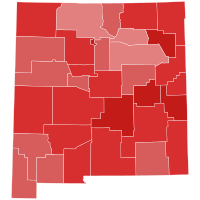 County results Domenici: 50–60% 60–70% 70–80% 80–90% | |||||||||||||||||
| |||||||||||||||||
Incumbent Republican Pete Domenici won re-election to a fourth term over Democratic State Senator Tom Benavidez.[29]
| Party | Candidate | Votes | % | |
|---|---|---|---|---|
| Republican | Pete Domenici (Incumbent) | 296,712 | 72.9% | |
| Democratic | Tom Benavidez | 110,033 | 27.0% | |
| Total votes | 406,745 | 100.00% | ||
| Majority | 186,679 | 45.9% | ||
| Republican hold | ||||
North Carolina
[edit]
| |||||||||||||||||
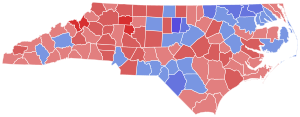 Helms: 50–60% 60–70% 70–80% Gantt: 50–60% 60–70% 70–80% | |||||||||||||||||
| |||||||||||||||||
The election was fought between the Republican incumbent Jesse Helms and the Democratic nominee Mayor of Charlotte Harvey Gantt. Helms won re-election to a fourth term by a slightly wider margin than the close election in 1984.
Helms drew controversy for airing what became known as the "Hands" ad produced by Alex Castellanos. It showed a pair of white hands with the voiceover saying "You needed that job, and you were the best qualified. But they had to give it to a minority because of a racial quota." The ad prompted allegations of racism.[31]
| Party | Candidate | Votes | % | ±% | |
|---|---|---|---|---|---|
| Republican | Jesse Helms (Incumbent) | 157,345 | 84.32% | −6.33% | |
| Republican | L. C. Nixon | 15,355 | 8.23% | N/A | |
| Republican | George Wimbish | 13,895 | 7.45% | −1.90% | |
| Turnout | 186,595 | ||||
| Party | Candidate | Votes | % | ±% | |
|---|---|---|---|---|---|
| Democratic | Harvey Gantt | 260,179 | 37.52% | N/A | |
| Democratic | Mike Easley | 209,934 | 30.27% | N/A | |
| Democratic | John Ingram | 120,990 | 17.45% | −8.78% | |
| Democratic | R. P. Thomas | 82,883 | 11.95% | N/A | |
| Democratic | Lloyd Gardner | 11,528 | 1.66% | N/A | |
| Democratic | Robert Hannan | 7,982 | 1.15% | N/A | |
| Turnout | 693,496 | ||||
| Party | Candidate | Votes | % | ±% | |
|---|---|---|---|---|---|
| Democratic | Harvey Gantt | 273,567 | 56.89% | +19.37% | |
| Democratic | Mike Easley | 207,283 | 43.11% | +12.84% | |
| Turnout | 480,850 | ||||
| Party | Candidate | Votes | % | ±% | |
|---|---|---|---|---|---|
| Republican | Jesse Helms (Incumbent) | 1,089,012 | 52.58% | +0.92% | |
| Democratic | Harvey Gantt | 981,573 | 47.39% | −0.42% | |
| Socialist Workers | Rich Stuart | 681 | 0.03% | −0.08% | |
| Turnout | 2,071,266 | ||||
| Majority | 107,439 | 5.19% | |||
| Republican hold | |||||
Oklahoma
[edit]
| |||||||||||||||||
| |||||||||||||||||
 County results Boren: 60–70% 70–80% 80–90% >90% | |||||||||||||||||
Incumbent Democrat David Boren won re-election to a third term over Republican attorney Stephen Jones.
| Party | Candidate | Votes | % | |
|---|---|---|---|---|
| Democratic | David Boren (Incumbent) | 735,684 | 83.2% | |
| Republican | Stephen Jones | 148,814 | 16.8% | |
| Majority | 586,870 | 66.4% | ||
| Total votes | 884,498[33] | 100.00% | ||
| Democratic hold | ||||
Oregon
[edit]
| |||||||||||||||||
 County results Hatfield: 40-50% 50-60% 60-70% Lonsdale: 40–50% 50–60% | |||||||||||||||||
| |||||||||||||||||
Republican Mark Hatfield was re-elected to a fifth term, defeating Democratic businessman Harry Lonsdale.
The front-runners emerged quickly: for the Republicans, Hatfield was in his fourth term and was the 8th most senior U.S. Senator, having previously served as Governor of Oregon for two terms and Oregon Secretary of State. For the Democrats, Harry Lonsdale, who had founded the biotechnology company Bend Research, announced in early 1990 that he intended to aggressively challenge Hatfield over the incumbent's ties to special interests, and his positions on abortion rights and timber management.[34]
In the Republican primary, Hatfield received a token challenge from Randy Prince, an environmentalist and former Eugene mayoral candidate who had once protested old-growth forest logging by tree sitting for 40 days.[35] Despite an early miscue by Hatfield in which he missed the deadline for submitting a photograph for the primary voter's guide,[35] Hatfield handily defeated Prince to move on to the general election.[36]
| Party | Candidate | Votes | % | |
|---|---|---|---|---|
| Republican | Mark Hatfield | 220,449 | 78.29% | |
| Republican | Randy Prince | 59,970 | 21.30% | |
| Republican | miscellaneous | 1,167 | 0.41% | |
| Total votes | 281,586 | 100.00% | ||
U.S. Congressman Ron Wyden considered challenging Hatfield, but decided against it.[37] Lonsdale, who was unknown as a politician, announced his campaign in March, and came out swinging directly at Hatfield and mostly ignored his primary challengers. Lonsdale's main campaign themes were abortion rights, which Hatfield opposed; and timber management, in which Lonsdale opposed exporting timber from Oregon forests and wanted to restrict logging in old-growth forests.[34] Lonsdale also criticized Hatfield as being out-of-touch with Oregonians after so many years in the Senate. Lonsdale announced that he would refuse to take special-interest contributions in his campaign, and would finance the campaign himself with the millions he had made from Bend Research.[34] Lonsdale easily defeated his competition: Salem attorney Steve Anderson, Pleasant Hill computer programmer Neale S. Hyatt, Milwaukie retired truck driver Brooks Washburne, Eugene activist Bob Reuschlein, and Frank A. Clough, also of Eugene.[34][38][39]
| Party | Candidate | Votes | % | |
|---|---|---|---|---|
| Democratic | Harry Lonsdale | 162,529 | 64.13% | |
| Democratic | Steve Anderson | 34,305 | 13.54% | |
| Democratic | Neale S. Hyatt | 20,684 | 8.16% | |
| Democratic | Brooks Washburne | 13,766 | 5.43% | |
| Democratic | Bob Reuschlein | 12,383 | 4.89% | |
| Democratic | Frank Clough | 8,235 | 3.25% | |
| Democratic | miscellaneous | 1,535 | 0.61% | |
| Total votes | 253,437 | 100.00% | ||
Once the primaries concluded, Hatfield, who had been first elected U.S. Senator in 1966, rolled out his usual campaign honed from his decades of experience: he refused debates, never engaged his opponent directly, and focused on small, friendly campaign appearances that stressed the influence he wielded as a U.S. Senator with seniority and influence.[37]
Lonsdale's self-financed campaign made heavy use of TV attack ads, criticizing Hatfield as being out of step with Oregonians on every issue, but primarily in terms of timber and abortion. He also made use of a nationwide anti-incumbency sentiment, and tore into Hatfield for being too closely tied to Washington special interests, and attempted to tie Hatfield to the Savings and loan crisis of the mid-1980s through his advisor Gerry Frank, who had ties to a Salem savings and loan.[37] By early October, polls showed the gap closing from 25 down to about 4 points in an early October poll conducted by The Oregonian newspaper, and by the end of October, some polls showed Lonsdale in the lead.[40]
With the polls running against him and time running out, Hatfield, who had not been seriously challenged since first being elected in 1966 and had never lost an election,[41] abandoned his tactic of staying above the fray and not engaging Lonsdale directly. In the media and in television ads, he charged Lonsdale with hypocrisy in his environmental stand, alleging that Lonsdale had allowed his company to illegally dump toxic chemicals into the environment.[42] Lonsdale vigorously denied the charges, which were later shown to have violated no laws, but the tactic may have stalled Lonsdale's momentum.[43] Hatfield went on to win in all but Multnomah, Jackson, Baker, and Lincoln counties to win by more than 7 percentage points statewide.[41]
| Party | Candidate | Votes | % | |
|---|---|---|---|---|
| Republican | Mark Hatfield (Incumbent) | 590,095 | 53.68% | |
| Democratic | Harry Lonsdale | 507,743 | 46.19% | |
| Write-In | Misc. | 1,417 | 0.13% | |
| Total votes | 1,099,255 | 100.00% | ||
| Republican hold | ||||
Rhode Island
[edit]
| |||||||||||||||||
Pell: 50–60% 60–70% 70–80% Schneider: 50–60% | |||||||||||||||||
| |||||||||||||||||
Democratic Incumbent Claiborne Pell defeated Republican Representative Claudine Schneider in a landslide.[45]
| Party | Candidate | Votes | % | ±% | |
|---|---|---|---|---|---|
| Democratic | Claiborne Pell (Incumbent) | 225,105 | 61.83% | −10.83% | |
| Republican | Claudine Schneider | 138,947 | 38.17% | +10.83% | |
| Majority | 86,158 | 23.67% | −21.65% | ||
| Turnout | 364,062 | ||||
| Democratic hold | Swing | ||||
South Carolina
[edit]
| |||||||||||||||||
| |||||||||||||||||
 County results
Thurmond: 50–60% 60–70% 70–80% Cunningham: 50–60% | |||||||||||||||||
| |||||||||||||||||
Popular incumbent Republican Strom Thurmond cruised to re-election against Democratic challenger and perennial candidate Bob Cunningham.
Senator Strom Thurmond faced no opposition from South Carolina Republicans and avoided a primary election. The state Democrats saw this as an unwinnable race so when Bob Cunningham sought the Democratic nomination, he was unopposed in his bid.
Cunningham launched his second bid to unseat Republican Sen. Strom Thurmond after switching from the GOP to the Democratic Party in early 1990. Though he faced a formidable opponent, Cunningham planned no fund-raising activities. "I don't plan to ask for anything and I won't accept any money from PACs," he said. Cunninghman said his campaign strategy was to "go to places where I was invited and spread out my ideas." If elected, Cummingham said he would push to limit consecutive congressional service to 12 years and reform the tax system. He supported greater environmental activism. "I think we're going at it in much too lukewarm a fashion. I think we should work hard to find a substitute for the internal combustion engine."
The election was never a serious contest. Thurmond overwhelmingly outspent Cunningham in his re-election campaign.
| Party | Candidate | Votes | % | ±% | |
|---|---|---|---|---|---|
| Republican | Strom Thurmond (Incumbent) | 482,032 | 64.2% | −2.6% | |
| Democratic | Bob Cunningham | 244,112 | 32.5% | +0.7% | |
| Libertarian | William H. Griffin | 13,804 | 1.8% | +0.4% | |
| American | Marion C. Metts | 10,317 | 1.4% | +1.4% | |
| No party | Write-Ins | 464 | 0.1% | +0.1% | |
| Majority | 237,920 | 31.7% | −3.3% | ||
| Turnout | 750,729 | 55.2% | −13.5% | ||
| Republican hold | Swing | ||||
South Dakota
[edit]
| |||||||||||||||||
| |||||||||||||||||
 County results Pressler: 40-50% 50-60% 60-70% 70-80% Muenster: 40–50% 50–60% | |||||||||||||||||
Incumbent Republican Larry Pressler won a narrow re-election battle against Democratic opponent Ted Muenster and Independent candidate Dean Sinclair, in contrast to his easy win in 1984.
| Party | Candidate | Votes | % | ±% | |
|---|---|---|---|---|---|
| Republican | Larry Pressler (Incumbent) | 135,682 | 52.39% | −22.1% | |
| Democratic | Theodore 'Ted' Muenster | 116,727 | 45.07% | +19.56% | |
| Independent | Dean L. Sinclair | 6,567 | 2.54% | N/A | |
| Majority | 18,955 | 7.32% | −41.66% | ||
| Turnout | 258,976 | 61.6% | −9.7% | ||
| Republican hold | Swing | ||||
Tennessee
[edit]
| |||||||||||||||||
| |||||||||||||||||
 County results Gore: 50–60% 60–70% 70–80% 80–90% | |||||||||||||||||
| |||||||||||||||||
Democratic Senator Al Gore won re-election to a second term over Republican William R. Hawkins, a conservative author. As of 2023, this is the last Senate election in Tennessee that was won by a Democrat and the last time they won the state's Class 2 Senate Seat.
| Party | Candidate | Votes | % | |
|---|---|---|---|---|
| Democratic | Al Gore (Incumbent) | 302,768 | 100.00% | |
| Total votes | 302,768 | 100.00% | ||
| Party | Candidate | Votes | % | |
|---|---|---|---|---|
| Democratic | Al Gore (Incumbent) | 529,914 | 67.72% | |
| Republican | William R. Hawkins | 233,324 | 29.92% | |
| Independent | Bill Jacox | 11,172 | 1.43% | |
| Independent | Charles Gordon Vick | 7,995 | 1.02% | |
| Write-ins | 109 | 0.01% | ||
| Total votes | 782,514 | 100.00% | ||
| Majority | 296,590 | 37.8% | ||
| Democratic hold | ||||
Texas
[edit]
| |||||||||||||||||
 County results Gramm: 40–50% 50–60% 60–70% 70–80% 80–90% Parmer: 40–50% 50–60% 60–70% 70–80% Tie: 50–60% | |||||||||||||||||
| |||||||||||||||||
Incumbent Republican Phil Gramm won re-election to a second term, beating Hugh Parmer, State Senator and former Mayor of Fort Worth[48]
Gramm, a popular incumbent who switched parties a few years prior, had over $5 million on hand.[49]
| Party | Candidate | Votes | % | |
|---|---|---|---|---|
| Republican | Phil Gramm (incumbent) | 2,302,357 | 60.2% | |
| Democratic | Hugh Parmer | 1,429,986 | 37.4% | |
| Libertarian | Gary Johnson | 89,089 | 2.4% | |
| Write In | Ira Calkins | 725 | 0.0% | |
| Total votes | 3,822,157 | 100.00% | ||
| Majority | 872,371 | 22.8% | ||
| Republican hold | ||||
Virginia
[edit]| Turnout | 25.5% (voting eligible)[51] | ||||||||||||||||
|---|---|---|---|---|---|---|---|---|---|---|---|---|---|---|---|---|---|
| |||||||||||||||||
 County and independent city results Warner: 60–70% 70–80% 80–90% >90% | |||||||||||||||||
| |||||||||||||||||
Incumbent Republican John W. Warner won re-election to a third term. No Democrat filed to run against him as he won every single county and city in the state with over 60% of the vote. Independent Nancy B. Spannaus (an affiliate of the controversial Lyndon LaRouche) got 18% of the vote, as she was the only other candidate on the ballot besides Warner.
| Party | Candidate | Votes | % | ±% | |
|---|---|---|---|---|---|
| Republican | John Warner (Incumbent) | 876,782 | 80.91% | +10.86% | |
| Independent | Nancy Spannaus | 196,755 | 18.16% | ||
| Write-ins | 10,153 | 0.94% | +0.93% | ||
| Majority | 680,027 | 62.75% | +22.65% | ||
| Turnout | 1,083,690 | ||||
| Republican hold | Swing | ||||
West Virginia
[edit]
| |||||||||||||||||
| |||||||||||||||||
 County results Rockefeller: 50–60% 60–70% 70–80% 80–90% Yoder: 50–60% | |||||||||||||||||
| |||||||||||||||||
The 1990 United States Senate election in West Virginia was held November 6, 1990. Incumbent Democratic U.S. Senator Jay Rockefeller won re-election to a second term.
| Party | Candidate | Votes | % | ±% | |
|---|---|---|---|---|---|
| Democratic | Jay Rockefeller (Incumbent) | 276,234 | 68.32% | +16.50% | |
| Republican | John C. Yoder | 128,071 | 31.68% | −16.05% | |
| Majority | 148,163 | 36.64% | +32.55% | ||
| Turnout | 404,305 | ≈35% | |||
| Democratic hold | Swing | ||||
Wyoming
[edit]
| |||||||||||||||||
| |||||||||||||||||
 County Results Simpson: 50-60% 60-70% 70-80% | |||||||||||||||||
| |||||||||||||||||
This section needs expansion. You can help by adding to it. (October 2017) |
Incumbent Republican Alan Simpson easily won re-election to a third term over Democratic challenger Kathy Helling.
| Party | Candidate | Votes | % | ±% | |
|---|---|---|---|---|---|
| Republican | Alan Simpson (Incumbent) | 100,784 | 63.94% | ||
| Democratic | Kathy Helling | 56,848 | 36.06% | ||
| Majority | 43,936 | 27.88% | |||
| Turnout | 157,632 | ||||
| Republican hold | Swing | ||||
See also
[edit]Notes
[edit]- ^ a b c As J. Bennett Johnston won Louisiana's jungle primary outright with a majority on October 6, he was listed unopposed for the general election on November 6. State law does not require tabulation of unopposed votes, thus the nationwide vote totals exclude Louisiana.[1]
- ^ a b Appointee elected
- ^ Senator Strom Thurmond was originally elected as a Democrat in 1954, but as a write-in candidate, a special election in 1956 and 1960 before switching to a Republican in 1964. Thurmond won re-election as a Republican in 1966, 1972, 1978 and 1984.
References
[edit]- ^ a b Clerk of the House of Representatives (1991-04-29). "Statistics of the Congressional Election of November 6, 1990" (PDF). U.S. Government Printing Office. p. 49.
- ^ "Our Campaigns - AL US Senate Race - Nov 06, 1990". www.ourcampaigns.com. Retrieved 20 December 2017.
- ^ "State of Alaska: Official Returns" (PDF). Archived from the original (PDF) on 2017-02-18. Retrieved 2017-10-11.
- ^ a b c d e f g h i j k l m n o p q Clerk of the House of Representatives (1991). "Statistics of the Congressional Election of November 6, 1990" (PDF). U.S. Government Printing Office.
- ^ "Colorado Voters Pick Candidates for Senate Race". The New York Times. Associated Press. August 16, 1990. Retrieved January 22, 2014.
- ^ Leip, David. "1992 U.S. Senatorial General Election Results - Colorado". U.S. Election Atlas. Retrieved February 27, 2013.
- ^ "Our Campaigns - HI US Senate - Special Election Race - Nov 06, 1990". www.ourcampaigns.com. Retrieved 20 December 2017.
- ^ "ID US Senate- R Primary Race - May 22, 1990". Our Campaigns. Retrieved February 4, 2014.
- ^ "ID US Senate- D Primary Race - May 22, 1990". Our Campaigns. Retrieved February 4, 2014.
- ^ "ID US Senate Race - Nov 06, 1990". Our Campaigns. Retrieved February 4, 2014.
- ^ a b Baxter, Elaine (June 5, 1990). "Primary Election" (PDF). Retrieved January 24, 2022.
- ^ "The Fort Scott Tribune - Google News Archive Search". news.google.com. Retrieved 20 December 2017.
- ^ "Our Campaigns - KS US Senate Race - Nov 05, 1996". www.ourcampaigns.com. Retrieved 20 December 2017.
- ^ a b "U.S. Senator: Primary Election". Archived from the original on 2010-11-13. Retrieved 2017-10-11.
- ^ "Louisiana GOP Refuses to Back Duke for Senate". Associated Press. 14 January 1990. Retrieved 20 December 2017 – via LA Times.
- ^ BROWNSTEIN, RONALD (7 October 1990). "Johnston Beats Duke, 54-43%, in Louisiana". Retrieved 20 December 2017 – via LA Times.
- ^ Applebome, Peter; Times, Special to The New York (5 October 1990). "Republican Quits Louisiana Race In Effort to Defeat Ex-Klansman". Retrieved 20 December 2017 – via NYTimes.com.
- ^ "Johnston Takes Lead Over Duke in Louisiana". Associated Press. 7 October 1990. Retrieved 20 December 2017 – via LA Times.
- ^ Applebome, Peter; Times, Special to The New York (7 October 1990). "Former Klan Figure Loses to Incumbent In Louisiana Voting". Retrieved 20 December 2017 – via NYTimes.com.
- ^ "Louisiana Secretary of State - Election Results".
- ^ "Our Campaigns - ME US Senate Race - Nov 06, 1990". www.ourcampaigns.com. Retrieved 20 December 2017.
- ^ "Our Campaigns - MA US Senate- R Primary Race - Sep 18, 1990". www.ourcampaigns.com. Retrieved 20 December 2017.
- ^ Parker, Randy; Reporting for Duty (April 9, 2005). "Our Campaigns: MI U.S. Senate". Our Campaigns.
- ^ "Our Campaigns - MN US Senate Race - Nov 06, 1990". www.ourcampaigns.com. Retrieved 20 December 2017.
- ^ The Bizarre Story of How a Hardcore Texas Leftist Became a Frontline Putin Propagandist, Tim Dickinson Rolling Stone, March 3, 2022 (archive)
- ^ a b "Report of the Official Canvass of the Vote Cast at the Primary Election Held in the State of Montana, June 5, 1990" (PDF). Montana Secretary of State. Archived from the original (PDF) on December 28, 2013. Retrieved July 2, 2014.
- ^ "Our Campaigns - NH US Senate Race - Nov 06, 1990". www.ourcampaigns.com. Retrieved 20 December 2017.
- ^ King, Wayne; Times, Special to The New York (8 November 1990). "THE 1990 ELECTIONS: What Went Wrong?; Bradley Says He Sensed Voter Fury But It Was Too Late to Do Anything". Retrieved 20 December 2017 – via NYTimes.com.
- ^ "Our Campaigns - Candidate - Tom Benavidez". www.ourcampaigns.com. Retrieved 20 December 2017.
- ^ "Our Campaigns - NM US Senate Race - Nov 05, 1996". www.ourcampaigns.com. Retrieved 20 December 2017.
- ^ Bouie, Jamelle (27 July 2012). "Apparently, the 'Real Racists' Are… Anti-Racists?". The Nation. Retrieved 20 December 2017.
- ^ a b c d "North Carolina DataNet #46" (PDF). University of North Carolina. April 2008. Archived from the original (PDF) on July 25, 2008. Retrieved June 12, 2009.
- ^ "1990 Oklahoma Election Results" (PDF). Oklahoma State Election Board. 1990. Retrieved November 4, 2018.
- ^ a b c d Attle, Rick (March 5, 1990). "Lonsdale blast launches Senate campaign". The Bulletin. Retrieved March 31, 2011.
- ^ a b "If you're looking for Hatfield..." The Register-Guard. March 16, 1990. Retrieved March 31, 2011.
- ^ a b "Oregon US Senate Republican Primary Race, May 15, 1990". ourcampaigns.com. Retrieved March 31, 2011.
- ^ a b c Walth, Brent (October 21, 1990). "Hatfield shifts gears in race". The Register-Guard. Retrieved March 31, 2011.
- ^ Boyd, Jim (March 9, 1990). "2nd Eugene man enters Senate race". The Register-Guard. Retrieved March 31, 2011.
- ^ a b "Oregon US Senate Democratic Primary Race, May 15, 1990". ourcampaigns.com. Retrieved March 31, 2011.
- ^ Walth, Brent (October 23, 1990). "Lonsdale leads race, poll shows". The Register-Guard. Retrieved March 31, 2011.
- ^ a b "Hatfield overcomes Lonsdale, anti-incumbent mood to win". The Bulletin. November 7, 1990. Retrieved March 31, 2011.
- ^ "State will look at claims of Bend Research dumping". The Register-Guard. October 19, 1990. Retrieved March 31, 2011.
- ^ Walth, Brent (March 21, 1992). "Lonsdale Firm's Hazardous Waste Violated No Rules". The Register-Guard. Retrieved March 31, 2011.
- ^ "Oregon US Senate Race, Nov 6, 1990". ourcampaigns.com. Retrieved March 31, 2011.
- ^ "Our Campaigns - RI US Senate Race - Nov 06, 1990". www.ourcampaigns.com. Retrieved 20 December 2017.
- ^ South Dakota Secretary of State, Historical Election Data. Accessed December 12, 2018.
- ^ "1990 Senatorial General Election Results - Tennessee". Archived from the original on 2014-02-26.
- ^ "Archives | Austin American-Statesman | Statesman.com". Nl.newsbank.com. July 1, 1990. Retrieved January 9, 2011.
- ^ "dallasnews.com | Archives". Nl.newsbank.com. October 17, 1990. Retrieved January 9, 2011.
- ^ "TX US Senate Race - Nov 06, 1990". Our Campaigns. Retrieved January 9, 2011.
- ^ Dr. Michael McDonald (March 25, 2013). "Turnout 1980-2012". George Mason University. Archived from the original on October 30, 2012. Retrieved April 3, 2013.
- ^ https://uselectionatlas.org/RESULTS/state.php?fips= 54&year= 1990&f= 0&off= 3&elect= 0&class= 2
- State Election Commission (1991). South Carolina Election Commission Annual Report 1990-1991. Columbia, SC: The Commission. p. 91.


